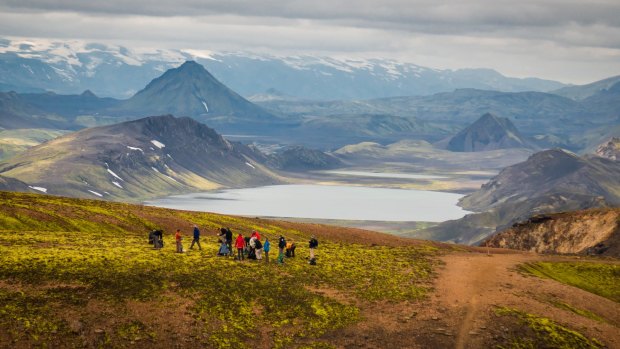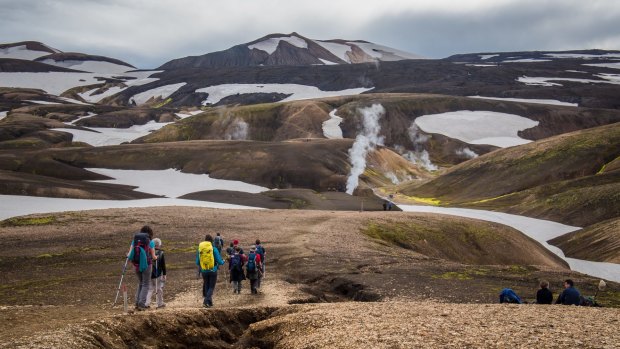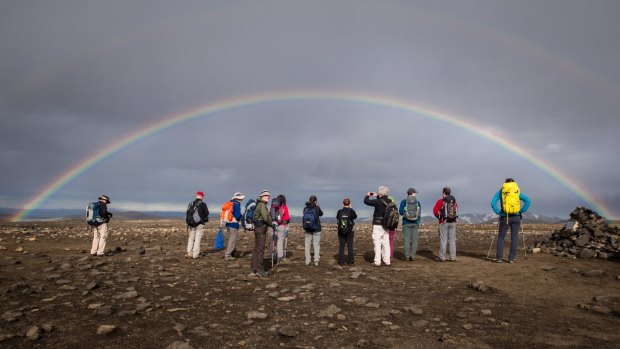This was published 2 years ago
Hiking Laugavegur, Iceland: A hot, steamy hike in a cold country
By Elspeth Callender

Laugavegur means 'the hot spring trail'.Credit: UTracks
Starting out on Iceland's most popular multi-day hiking route there's an expectation of colourful landscapes and geothermal drama this country is famous for, yet none of our group anticipates the cohesive nature of Laugavegur.
"The weather in the mountains is a little bit shitty today," says Ingibjorg Gudjonsdottir after introductions around the circle at Reykjavik's central bus station.
For four full days this veteran guide, of small stature and commanding presence, will lead 13 of us, a a mix of solo travellers, siblings, friends and couples aged 21 and upwards from six different countries. The eldest is a New Yorker in her late sixties called Tui. Our driver, Thor Helgason, is a quiet sheep farmer and longstanding friend of Ingibjorg's who transports our luggage and food between remote huts. It's early September and the last hike of the season.

We walk among the ghostly bodies of sulphuric steam levitating above the lava field.Credit: Utracks
Laugavegur, meaning "the hot spring trail", begins at Landmannalaugar in Iceland's south highlands where it's 10 degrees and drizzling when we arrive. Ideal conditions for a dip in a thermal creek. This turns out to be a real ice-breaker for strangers about to set off alongside each other, share every meal, sleep in close proximity and cross rivers together in their underpants.
Iceland is a Nordic country that hangs like a pendant on the Arctic Circle. It's about one and a half times the size of Tasmania with the population a bit bigger than Newcastle. Despite national tourism exploding after Eyjafjallajokull erupted in 2010 – grounding planes across Europe and twisting tongues internationally – few of Iceland's 330,000 citizens have felt the need to fashion themselves a false facade for visitors.
Like volcanoes, the intense warmth is not always exteriorly apparent.

There won't be a tree to see for days.Credit: UTracks
Located between Greenland and Norway, where the North Atlantic meets the Arctic Ocean, the island was settled from the late 8th century by Celtic monks and pagan Norse people. An isolated population in the tens of thousands somehow survived the volcanic activity, sub-Arctic climate, inherent risks of seafaring and bubonic plague. Old Norse lettering and spelling have also survived, meaning Icelanders today can read the sagas etched on ancient calfskin.
Our journey on foot begins up the side of a volcano that hasn't erupted for at least half a millennium. That's a very long time by Icelandic standards; since 1900 there have been more than 50 isolated eruptions from the island's 30 active systems. For Icelanders, volcanoes are a part of life.
After Grimsvotn erupted beneath its glacier back in 1996, Ingibjorg and her husband raced towards the south of Iceland for the spectacle of gigantic high-and-dry icebergs scattered across the sand deltas of Skeithararsandur. Grimsvotn erupted again in 2011. Icecap-covered Eyjafjallajokull, visible from Laugavegur, has been going off occasionally since the last Ice Age.
From Landmannalaugar we walk among the ghostly bodies of sulphuric steam levitating above the lava field. White ground in one area warns of a dangerously thin crust. A threadbare rug of fluorescent green moss carpets a volcanic-black ridge. The bare soil of another slope is rust-coloured.
There won't be a tree to see for days. And even then, Ingibjorg explains, "we say that if you get lost in an Icelandic forest, stand up". That afternoon we huddle together under our guide's lightweight orange tarp for a communal steam bath over a small opening to a hot spring then walk across an exposed plateau into icy wind and stinging rain.
Although Iceland's climate is relatively mild for its latitude and the route's highest point is only 1059 metres, another chilling reminder of the unpredictability of its weather stands just one kilometre shy of Hrafntinnusker Hut: a memorial plaque to a 25-year-old Israeli tourist. Ido Keinan was inexperienced and alone when he perished on that spot during a midsummer storm in 2004.
When we arrive at Hrafntinnusker, the hut's mud room is already heaving with saturated wet-weather gear. Our group has its own space, already reserved, with bunkbeds for everyone and a long central table. Thor is already there with our luggage and fresh salmon. Ingibjorg, who's a wizard of a cook, recruits some of us to help her prepare traditional fish soup.
Outside, other hikers pitch tents in the swirling mist. After Ingibjorg has coerced us into third and fourth helpings she suggests we offer campers the remaining soup. It's still light, but some people are already in their tents while others huddle at a three-sided cooking shelter. The creamy broth is most appreciated by a couple standing side-by-side at their campsite as though posing for a photograph nobody's taking. One of them is holding up a semi-depleted bottle of absinthe and they confess to failing all three attempts to prepare dinner. When I step back into the dry warmth of the hut I experience actual joy.
There's no magic formula for building a cohesive group but the combination of personalities, Ingibjorg's leadership, the physical achievements of the first day and a cosy hut to call home for the night bond the group like cooled lava. As does the rice wine the couple from South Korea insist on sharing around every evening.
The next morning the clouds start to lift and the landscape opens up. Views from Laugavegur are like something from an exquisitely illustrated children's book – every freshly turned page so different to the last. Our elongated shadows follow us across snowfields like silver monsters, we gaze down into lush valleys that are undoubtedly enchanted and traverse dusty volcanic plains that could be the surface of another planet. Attempts to pronounce the Icelandic names for these places make us sound like we're still learning to talk.
Every hut is a welcome sight. Alftavatn, on the second night, has several buildings including a little restaurant bar and a shower block I line up at after a plunge in the frigid lake. Before sunset, some of us climb a nearby hill to see Myrdalsjokull – the glacier covering a volcano named Katla.
The stories of witches and trolls Ingibjorg tells, including those about cranky Katla and her magic running trousers, don't seem at all far-fetched on Laugavegur. And we're rewarded for believing: Katla slumbers and the weather fairies remain on our side. At Alftavatn we lie in our sleeping bags on the boardwalk under the clear night sky scanning for northern lights. The next day, after a picnic lunch, we all sprawl out on the grass in the sunshine.
Ingibjorg often leads us off-piste to avoid other hiking groups or reduce river crossings, yet sometimes there's no alternative but to ford. On the bank of Brattakvisl, we all strip down on the bottom half to undies so our trousers stay dry. We form a pack in lines of three and four. The brothers are hand-in-hand, friends are arm-in-arm, the rest of us link elbows and clasp hands and Ingibjorg gets a firm hold on Tui. On our guide's command we walk forward, as one, through the deep rush of freezing water.
THE DETAILS
FLY
Qantas (and airline partners) flies from Sydney and Melbourne to Reykjavik (Iceland) via cities such as Singapore, London and Helsinki. See qantas.com
STAY
Hotel Eyja Guldsmeden is a 65-room eco-hotel in a converted office block within walking distance of central Reykjavik. From $255 for a double room. See hoteleyja.is
EAT
Try Saegreifinn for fresh seafood dishes, like lobster soup and fish-on-a-stick, in a casual traditional-style restaurant that won't breaking the bank. See facebook.com/saegreifinn.seabaron
TOUR
UTracks, offers an extensive collection of guided and self-guided walking and cycling trips of varying lengths. The five-day hut-based Laugavegur Trail Guided Walk, from Landmannalaugar to Thorsmork (55 kilometres), has departures until mid-September from $3490 a person. See utracks.com
MORE
Elspeth Callender travelled as a guest of UTracks.
FIVE MORE OUTDOOR SUMMER ACTIVITIES IN ICELAND
CYCLE THE REYKJAVIK COAST
Spend a bright evening pedalling the coast around Reykjavik. This relatively flat 18-kilometre guided bicycle ride takes in lighthouses, bird sanctuaries and thermal beaches. See icelandbike.com
HIKE MOUNT ESJA
Reykjavik's skyline is dominated by a 914-metre flat-topped range. You can hike it independently or join a half-day guided tour that includes hot springs and beer tasting. See getyourguide.com
SWIM AT HOFSOS
For a fraction of the cost of Blue Lagoon, head to this outdoor geothermal public pool with a view for some sub-Arctic laps or just a scenic splash. See facebook.com/sundlauginhofsosi/
KAYAK GLACIER LAGOON
This full daytrip from Reykjavik to the South Coast will have you kayaking between icebergs, taking in the glacier of Solheimajokul and walking behind the falling waters of 65-metre Seljalandsfoss. See mountainguides.is
GO BACK IN TIME
Join a two-day Authentic Iceland tour at Obyggdasetur Islands – Wilderness Centre in Egilsstadir. Stay overnight in a traditional turf house to experience how Icelanders once lived. See wilderness.is
Sign up for the Traveller Deals newsletter
Get exclusive travel deals delivered straight to your inbox. Sign up now.